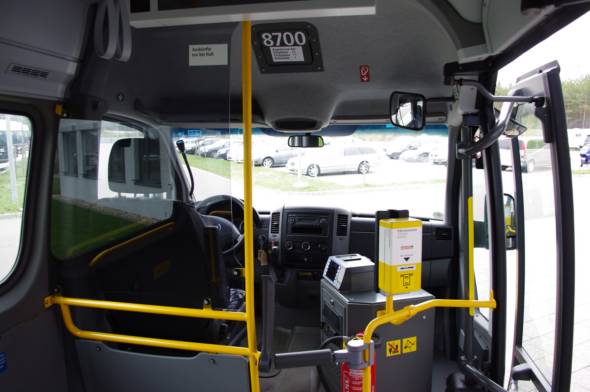New stars under Berlin’s sky


- 27 Mercedes-Benz Sprinter City 35 for the Berlin taxi drivers’ guild
Stuttgart/Berlin – Now it is no longer necessary to wait until dark in Berlin to watch for “shooting stars”, because there are 27 Mercedes-Benz urban minibuses to be seen around town. The official handover of these vehicles to the Berlin taxi drivers’ guild was recently held at the German Automobile Club (ADAC) safety centre in Linthe.
The models of the Sprinter City 35 will be used on routes that have a low number of passengers. These generally comprise shift workers, nocturnal revellers and also the occasional tourists who rely on public transport within what are known as the “exurbs” – the ring of affluent suburbs around the German capital.

Bernd Dörendahl, chairman of the Berlin taxi drivers’ guild, explained: “Our principal role is to provide connections for people using public transport routes, bringing them home at night from underground or suburban rail stations.” The taxi association is breaking new ground in deploying the Mercedes Sprinter City vehicles, particularly in relation to certification, technology and staff qualification. The managers responsible decided to opt for Mercedes-Benz vehicles, on the one hand, because of their reliability, standards of driver and passenger safety, and the level of comfort. Another decisive factor was the smooth-functioning, all-round service that businesspeople in the taxi industry have come to know and appreciate. “We have contacts right here on the spot,” said Dörendahl.
Until recently, for economic reasons, the routes on which the Sprinter City minibuses will be used were serviced by taxi vans. However, when the Berlin Transportation Company (BVG) established that the number of passengers was steadily rising, it felt it was time to act. The BVG subsequently invited tenders for the service contract, with the winning offer coming from EvoBus GmbH, responsible for brand sales of Mercedes-Benz omnibuses. With twelve seats and room for ten standing passengers, the Sprinter City 35 vehicles were the perfect size for the job, and included a bay for a wheelchair or pushchair. The future operators are members of the Berlin taxi drivers’ guild, or Berliner Taxigewerbe e. V., and are all private taxi and bus companies who have provided services on less frequented routes in the past. One of the requirements they had to meet was that the vehicles needed to be properly equipped for disabled passengers.
The interior appointments in the minibuses also focused on the latest requirements. For example, the Sprinter City 35 has a computerised operations control system that connects each individual vehicle with headquarters and the bus stops, and the ticketing system is fully electronic. This should come as no surprise, since Mercedes-Benz incorporated its vast experience from the city bus sector into the development of the Sprinter City. A radio system and an alarm button are included as optional extras.
Like all the Mercedes-Benz minibuses, the 27 Sprinter City vehicles for Berlin were built at the Mercedes-Benz minibus plant in Dortmund. The factory operates as Mercedes-Benz Minibus GmbH and is a wholly owned subsidiary of EvoBus GmbH, which in turn is a wholly owned subsidiary of Daimler AG. One of the leading suppliers in its segment in Europe, it offers a 24-month warranty for material defects on all vehicle scopes across the full minibus range.
The Mercedes-Benz minibus program currently comprises 12 models, distributed across the four model series Sprinter Transfer, Sprinter Travel, Sprinter City and Sprinter Mobility. The minibuses, which were developed for use in urban, intercity and tourism and mobility transport services, have a permissible gross vehicle weight of between 3.5 and 5.65 tonnes, with vehicle lengths of between 5.9 and 7.7 metres.
The Sprinter Transfer model series is customised for the following application ranges: intercity routes, shuttle services and day excursion transport. The range includes five different large intercity variants, with space for up to 22 passengers. The Sprinter Travel model series provides a high level of travel comfort for up to 19 passengers – also suitable for trips lasting several days. Sprinter City is the name of the model variant with a low-floor design for use on city routes, offering seating and standing room for up to 30 passengers. Finally, the Sprinter Mobility segment is designed for the transport of passengers with restricted mobility.

The Sprinter City model range is a genuine specialist for regular services within a local area. Whereas the compact Sprinter City 35 (length 6.9 metres, for up to 22 passengers) is based on a modified panel van, the second model, the larger Sprinter City 65 (length 7.7 metres, for up to 30 passengers),is instantly recognisable from its fully independent design and its panoramic window glazing. Both models are ideally suited for use in city traffic, with a double-wing outward-swinging door at the front and with a clear opening width of 1,250 millimetres. The entrance door leads across a flat entrance to the spacious low-floor area between the axles, presently comprising approx. 3.2 square meters in the City 35 and 3.6 square meters in the City 65. There is ample space here for standing passengers, and also sufficient space for pushchairs or wheelchairs. A folding ramp ensures easy boarding and alighting for passengers with restricted mobility, or parents with a pushchair.
Seating consists of light, anatomically shaped City-Star Eco plastic bucket seats with seat cushions and back padding. An additional single-wing outward-swinging door behind the rear axle is part of the standard series equipment in the Sprinter City 65.
The Sprinter City model series stands out because of its comprehensive range of fittings, which are both functional and attractive, and features conscious borrowings from its larger stable mate, the Mercedes-Benz Citaro, in terms of colour scheme, floor and side wall cladding, seats and modular ceiling. This is also true of the air conditioning comfort. The range of fittings in this area includes high-performance convector heaters with axial fans, and driver and passenger air conditioning systems with fresh and recirculated air functions.
This urban regular-service bus is powered by Euro-5-compliant, four-cylinder diesel engines with a standard engine output of 95 kW (129 hp) in the Sprinter City 35 and 120 kW (163 hp) in the Sprinter City 65. A convenient five-gear automatic transmission handles the force transmitted to the rear axle. While rear axle air suspension is an optional extra for the Sprinter City 35, it is fitted as standard on the larger model. The optional kneeling function for maximum convenience when getting on and off is reserved for the larger variant, but a retarder is supplied with both urban bus variants. The permissible gross vehicle weight for the Sprinter City 35 is 5.0 tonnes while that for the larger Sprinter City 65 is 5.65 tonnes (standard), because of the greater number of passengers it carries.





